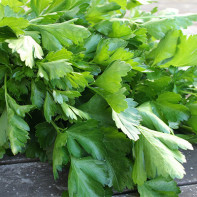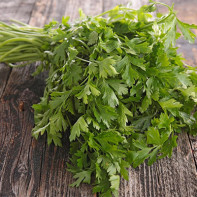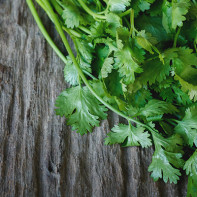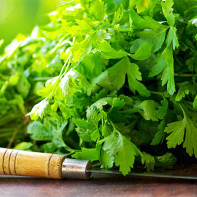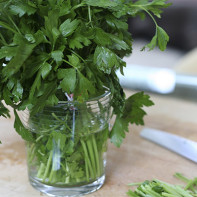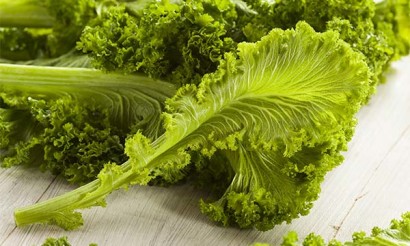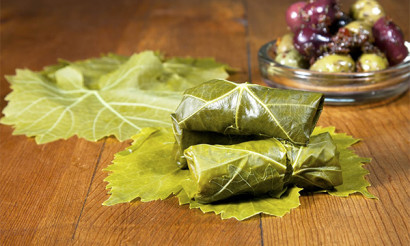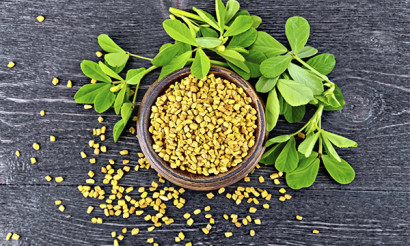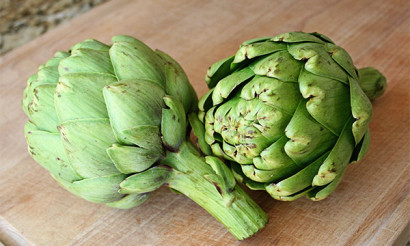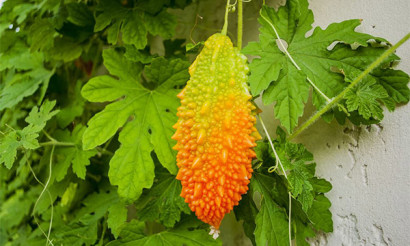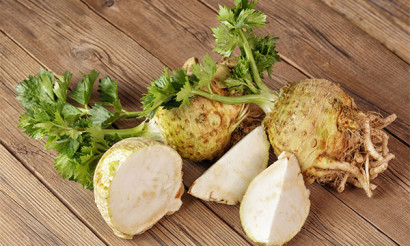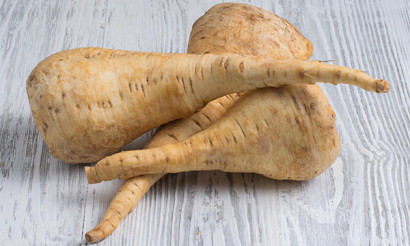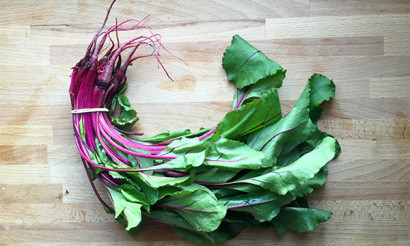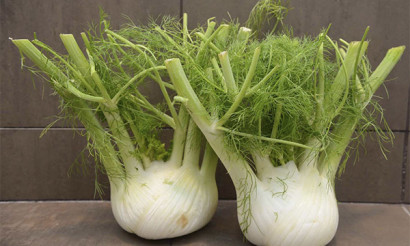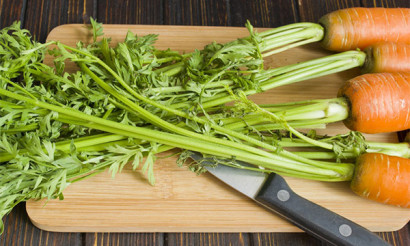Parsley: useful properties and contraindications
Parsley is a familiar to everyone greens, the most common spice in the beds of Russian vegetable gardens. Meanwhile, not everyone knows what is the usefulness of parsley, and how it can be used.
- Types of parsley
- What is the difference between parsley and cilantro
- What is healthier: cilantro or parsley
- Composition and calories
- Useful properties of parsley
- General benefits
- For Women
- For Men
- In Pregnancy
- When breastfeeding
- For Children
- How to take parsley for weight loss
- Decoction
- Infusion
- Tea
- Therapeutic Properties of Parsley Seeds
- What is the usefulness of parsley root
- The benefits of parsley juice
- How to squeeze the juice
- Dried parsley: benefits and harms
- How to Dry
- The benefits of parsley with kefir
- Parsley in medicine
- Diabetes mellitus
- In pancreatitis
- For Gastritis
- For Intestines
- For constipation
- For gout
- For the liver
- For hemorrhoids
- For cholecystitis
- For Swelling
- Recipes of folk medicine based on parsley
- Parsley in cosmetology
- For Face
- For Hair
- Cooking
- Harm and Contraindications
- How to choose and store parsley
- Can I freeze it?
- How to eat parsley?
- How much can I eat per day?
- Can I Eat at Night and on an empty stomach?
- Can I eat the stems?
- Can I Eat Flowering Parsley?
- Can we give parsley to animals?
- Interesting facts about parsley
Types of parsley
There are two main types of parsley - root parsley and leaf parsley. Both are close in terms of nutritional value and chemical composition. Only in the first case parsley is grown for the roots, and in the second - for the greens.
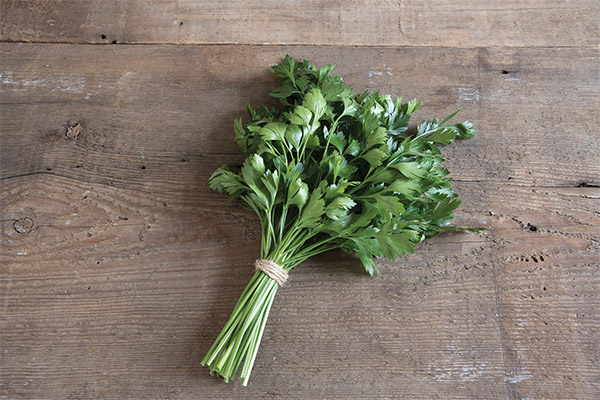
There is also a popular variety of leafy parsley called curly parsley. It is often used for decorative purposes, because it really looks unusual - it has dark green leaves with curved, as if corrugated edges, which form a fairly large and dense rosette. The greens of this parsley do not turn yellow for a long time, retain their freshness and spicy aroma for a week after cutting. It also differs from the usual leafy variety in that it contains more mineral salts, carotene and ascorbic acid.
A separate hybrid of root and leaf parsley, called the Hamburg variety, should be mentioned. It is characterized by relatively larger root crops with a spicy taste reminiscent of both celery and parsnip at the same time.
What is the difference between parsley and cilantro?
Both parsley and cilantro belong to the Umbrella family. Externally, these plants are very similar. But there are certain differences between them.
- Parsley leaves are larger, tougher and have a bright green hue. They are more elongated in length, but are considered less wavy.
- The main difference is the smell, it will help "identify" the plant literally in seconds. The fact that cilantro leaves have a strong lemon-pepper aroma (decyl aldehyde contained in the essential oil is responsible for it). This smell is considered by many to be too strong.
- Cilantro seeds (better known as coriander) also have a strong smell. There is a perception that it resembles the smell of a bedbug. But in fact, only unripe seeds have this unpleasant odor. If we are talking about ripe coriander, then it has a pleasant smell, which causes associations with Borodinsky bread.
Which is healthier: cilantro or parsley
If we consider only the basic medicinal properties of these herbs, we can see that they both have beneficial qualities. For example, parsley has antiedematous, diuretic and anti-inflammatory effects. While cilantro has antiseptic, antihelminthic and analgesic properties.
However, parsley is considered more useful because it contains many more vitamins. For example, while 100 g of cilantro contains only 27 mg of vitamin C, the same amount of parsley contains 133 mg. The same goes for vitamin K - 310 mcg and 1,640 mcg, respectively.
In addition, cilantro has a specific taste and aroma. For some people, its smell is repulsive. While parsley with its milder taste and aroma is a more versatile condiment, because it does not cause any negative emotions.
Composition and calories
The energy value of any leafy greens is relatively low. For example, parsley has about 49 kcal per 100 grams. But this plant's greens, seeds and root contain a huge number of useful substances, the presence of which is due to its therapeutic properties.
The composition of both greens and the root part of parsley includes such useful substances:
- Ascorbic acid, which is an antioxidant with anti-inflammatory properties. It is also essential for strengthening vascular walls.
- Vitamin E is another powerful antioxidant necessary for both metabolic processes and the prevention of cardiovascular disease.
- Vitamin B2 (modern name - riboflavin) is responsible for the condition of the skin, improves eyesight, supports the normal functioning of the nervous system.
- Vitamin B9, or folic acid - this substance is involved in the processes of hematopoiesis, it is necessary for the normalization of the liver and increase cognitive abilities, folic acid is especially useful in pregnancy.
- Vitamin PP - is involved in the production of gastric juice, it is responsible for normalizing oxidative processes.
- Phosphorus is responsible for cognitive functions and metabolism.
- Salts of magnesium and potassium - are necessary for normalization of cardiac activity.
- Iron - this element is involved in the processes of hematopoiesis, helps to prevent anemia.
Also in the composition of parsley includes many essential oils. They have a wide range of action, which allows their use in pharmacology, and in cooking, and in cosmetology.
Useful properties of parsley
General usefulness
You can hardly find a more useful plant than parsley. This spicy herb:
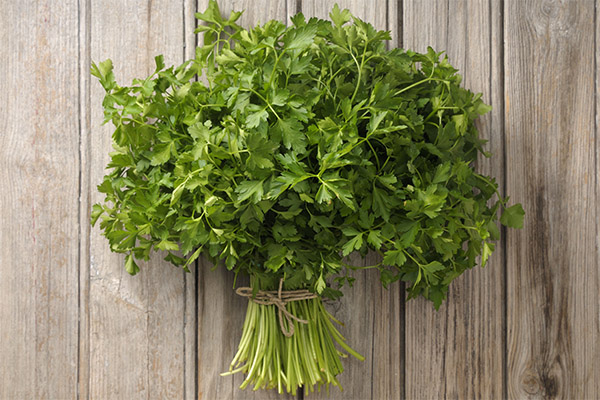
- Possesses diuretic and analgesic properties.
- It has a diarrheal effect, that is, it can cope with such a problem as increased gas.
- Improves digestion.
- Beneficial effect on hematopoiesis in general and helps to increase blood clotting.
- Improves the immune system.
- Has anti-inflammatory properties.
- Helps relieve fatigue.
And this herb also freshens the breath, which is very important in the presence of some diseases of the mouth.
The essential oils contained in the leaves of parsley have found wide application in medicine and cosmetology. In the first case, they are used due to their constituent antioxidants (it has been proven that they have not only anti-inflammatory, but also anti-tumor properties). They also have an antiseptic effect, in particular they disinfect the oral cavity, so they are an excellent prophylactic against stomatitis.
As for the use of parsley essential oils in cosmetology, they stimulate the activity of hair follicles, help to smooth out wrinkles and can even be used against cellulite.
For women
For the fairer sex, parsley is especially useful. This is due to the presence of myristicin and apiol in its composition. It is thanks to these substances that the tone of the intestines, bladder and smooth muscles in the uterus increases. But the most important thing is that the mentioned compound apiol is a plant analogue of estrogen, the most important female hormone. It is because of this parsley helps to normalize the menstrual cycle, make the manifestations of PMS less pronounced and even completely eliminate the painful sensations, improve health during menopause.
Parsley is considered a very useful spice for the skin. It helps to get rid of age spots, which is especially important during hormonal surges, such as pregnancy or menopause. It also cares for aging skin and helps maintain its tone. For teenagers, it is useful because its juice can be used to treat acne.
And parsley also helps to stimulate digestion, eliminate toxins, and get rid of even long-formed fat deposits. Some nutritionists advise to add parsley to any diet, because its greens contain substances that suppress hunger. Thanks to this, any restrictions are more easily perceived by the body. Not to mention the fact that the use of this greens helps to make up for the lack of enzymes and vitamins even during a strict mono-diet.
For men
The benefits of parsley for the representatives of the stronger half of mankind are to increase potency, improve prostate function, increase blood circulation (this helps to prevent inflammatory diseases and normalizes erectile function). All these properties are due to the fact that it contains apigenin. This compound regulates the hormonal balance, reducing the production of estrogen (the male body must synthesize it, but only in very small quantities) and stimulating the formation of necessary testosterone.
In addition to the fact that parsley helps to cope with many problems characteristic of the reproductive system, it is also useful in that it helps to remove toxins from the body faster in case of alcoholic intoxication.
In pregnancy
Future mothers are often wary of various spices, and this is quite understandable. There is an opinion that because of the content of myristicin and apiol, parsley strongly increases the tone of the uterus. However, in order for this to pose a threat to pregnancy termination, parsley should be eaten literally in bunches. This is also true for potassium, which is considered harmful to expectant mothers. But in fact, if you use a small amount of parsley during pregnancy, there will be no harm from parsley. On the contrary, starting from the 20-25th week of pregnancy, this herb will be the best way to prevent edema.
In addition, it is very important to ensure that future moms who suffer from cardiovascular diseases, have abnormalities of the kidneys and bladder, receive a sufficient amount of potassium. The fact is that potassium helps to remove excess fluid and sodium from the body faster.
When breastfeeding
Many women are afraid to include parsley in their diet during lactation, because the substances it contains, getting into the breast milk, can cause the baby overstimulation. In fact, this is not entirely true. To get exactly this effect, you need to eat this spice in very large quantities. And moderate use will not cause any unpleasant effects. If you just periodically add a little parsley to a cooked soup or salad, you can improve the composition of breast milk.
For babies
There is an opinion among young mothers that children should not be given parsley, saying that it causes overexcitement. But first, parsley seeds are antipyrogenic, and the tea from them, as well as dill water, can relieve the pain of colic. But it should be given in very small quantities.
And secondly, parsley is very useful for children's teeth, because it contains a lot of fluoride of natural origin, and it is much more useful than its counterpart in synthetic toothpaste. Therefore, such greens are recommended to include even in the diet of very young children who have begun to be teething. The consumption of parsley will help make the teeth resistant to the development of cavities, and also brighten them and make them cleaner.
How to take parsley for weight loss
These greens contain many useful substances that accelerate metabolic processes. It also contains compounds that allow the body to cleanse itself faster from toxins. They support the liver, stimulate intestinal peristalsis, normalize blood pressure. And inulin, present in large quantities in parsley (both leaves and roots) regulates blood glucose levels.
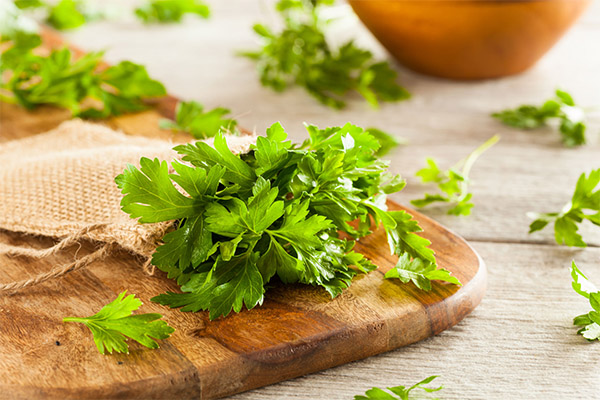
All this contributes to weight loss, but only if you properly take advantage of the benefits that this product provides. For example, parsley root can be used in a fairly strict diet to speed up the elimination of extra pounds while providing the body with all the substances it needs.
The menu of this diet can be as follows:
- Breakfast consists only of a cup of natural coffee with 1 tsp. sugar, but without milk.
- The second breakfast consists of 100 g of low-fat hard cheese or 200 g of cottage cheese, a cup of green tea.
- Lunch - 100 g of boiled chicken or turkey, 1 tablespoon of grated parsley root.
- Afternoon snack - 1 boiled egg and 1 tablespoon of parsley root.
- Dinner - a glass of nonfat kefir.
You can sit on such a diet for no longer than three days. Of course, it is contraindicated for gastritis, ulcers, inflammatory bowel diseases.
Decoction
Decoction of parsley is considered an excellent tool for weight loss. He helps to remove excess fluid from the body and reduce swelling. In addition, its use reduces the feeling of hunger, which allows you to give up snacks and reduce portions, which also contributes to weight loss.
The decoction should be prepared as follows: the parsley leaves should be finely chopped, and then ground in a mortar, so that the juice begins to emerge from them. After that, you need to pour boiling water over the herbs (a glass of water for 2 tsp. vegetable raw materials) and then cook this mixture over low heat for 15 minutes. Then wait until the decoction cools and strain it. Use 100 ml (this is a small teaspoon) whenever you feel hunger. It is best to do this as a course of two weeks. During this time, you should also limit yourself in flour and sweets, give up fatty foods, but you can eat boiled meat, buckwheat and rice, dairy products, vegetables and fruits.
There is another way to lose weight on decoction of parsley. One should pour two liters of boiling water over 100 grams of fresh parsley leaves, simmer on low heat for 10-15 minutes and then cool, strain and add the juice of one lemon. This broth should be drunk little by little, just a few sips. If hunger becomes particularly strong, then, in addition to the broth, you can also eat a few slices of orange. In this case you should follow a very strict diet. In this case, the duration of the treatment course is no longer than 10 days.
Infusion .
To prepare the infusion, you need to take 2 tsp. spoons of chopped parsley herb and pour a glass of boiling water, and then insist for 20-30 minutes. Strain this remedy before use. It is recommended to take 1 cup, on an empty stomach, in the morning, for two weeks. Then be sure to take a break for 14 days, and after that the course can be repeated again. If you observe certain restrictions on food, then during this time it is possible to lose 4-5 kilograms.
Tea
Tea from parsley can also help weight loss. To do this, you need to take 15 g of fresh parsley greens for 50 ml of boiling water, which should be chopped beforehand. In winter, when only greenhouse greens are available, which contain much less useful substances, you can take dried parsley - 2 tbsp. spoon per glass of boiling water. Brew it in the same way as normal tea, ie insist for 5-10 minutes and be sure to filter it. It is recommended to drink it warm, adding a little lemon sugar or honey. Such a tea contains fewer biologically active substances, and it can be taken for several months in a row. But you need to remember that it has a certain calming effect.
Therapeutic properties of parsley seeds
Parsley seeds contain many of those chemical compounds that are then present in adult plants. In folk medicine, they are used to stimulate appetite in gastritis with reduced acidity, improve digestion and intestinal peristalsis, normalize the menstrual cycle.
Most often, they are used to brew tea (1 tbsp of seeds per glass of boiling water), which also helps to relieve the pain of colic and cramps, reduce the manifestations of inflammation.
What is the usefulness of parsley root
Both in cooking and in folk medicine, the root parsley is widely used. Its greens contain fewer vitamins and minerals than the leafy ones (although in general the chemical composition is identical). But the roots of this variety are much higher in content of organic acids, minerals, vitamins and essential oils than the above-ground part.
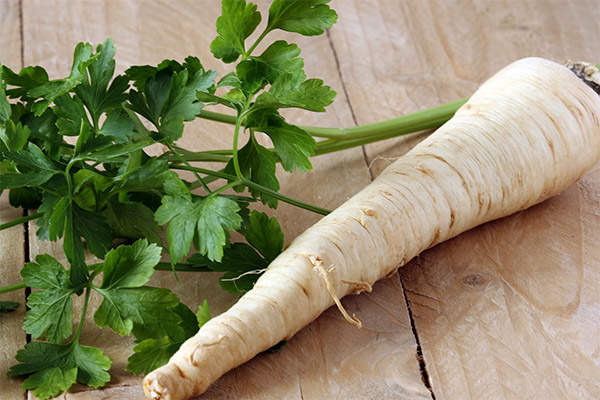
Parsley root is used as an antiseptic for the mouth, it is also a great option to boost immunity. Also, parsley root:
- Normalizes the liver and hepatobiliary system.
- Removes toxins and reduces swelling.
- Is a preventive and therapeutic agent for constipation.
- Used as an aid in the treatment of prostatitis due to its anti-inflammatory properties.
- Improves the performance of the digestive system.
- Regulates the level of glucose in diabetes.
- Accelerates metabolism and is used as an aid in the treatment of obesity.
- It is used as an anti-inflammatory and analgesic in the treatment of rheumatism.
In this folk medicine, both fresh and dried parsley root can be used. It is harvested in late fall, trying to harvest it before the onset of severe frosts.
Since the parsley root contains even more biologically active substances, you should use it with more caution than the greens. In particular, it can have a negative effect on calcium metabolism.
The benefits of parsley juice
Parsley juice has the same properties as its greens. However, all the vitamins, trace elements and bioflavonoids it contains as if in a concentrated form, so it is considered more useful. In addition, when getting into the body with liquid, these substances are better absorbed.
How to squeeze the juice
To prepare the parsley juice, the greens should be prepared - thoroughly washed, chopped in any way convenient for the hostess, for example, you can chop the stems and leaves with a knife or process in a blender. Then squeeze the juice from the resulting mass. To do this, it should be placed in a kind of filter, made of folded in several layers of gauze.
It is believed that the more operations are done manually, the more useful the resulting juice will be. The fact is that in contact with metal there are always oxidative processes, due to which some of the unstable chemical compounds are destroyed.
The resulting juice should be used immediately. You can't just store it in the fridge. Unless you can freeze the juice in a mold for ice and use it not for food, but for cosmetic purposes. For this purpose, it can even be diluted with purified boiled water (of course, cold), as the skin does not need a high concentration of biologically active substances.
Dried parsley: benefits and harms
Dried parsley has almost the same properties as fresh parsley. Of course, some of the useful substances are destroyed, but most of them are preserved. It is important only to follow all the rules of drying, so that in the future such a product will be beneficial.
How to dry
The drying process in this case will be the same as for any other spicy greens from the garden. This means that the greens should be thoroughly washed, shake off the remaining water, dry on a cloth or paper towel. Then spread them out on trays or stretched out sheets of fairly thick white paper. Never dry parsley on newspapers, as the printing ink contains harmful substances that can be absorbed into the stems and leaves.
Parsley should be dried outdoors, but preferably in the shade or under a canopy, because oxidation processes start to occur when in contact with direct sunlight. Theoretically, you can also do it in the kitchen of a city apartment, if there is enough space for it.
Spread the greens on the paper is better to spread a thin layer, to ensure that all parts of the plant have access to air. In the process, the greens will need to be periodically stirred up a little for even drying, this is done manually. This will take several days. You just need to wait for the leaves and stems to start to break down. After that, they can be shredded and poured for further storage in a glass jar or paper bags.
It should be noted that you can dry not only the leaves, but also the root of parsley. Only it is previously recommended to cut it into thin enough bars to speed up the process. It will take more time to dry than the greens. But in winter it will give a pleasant taste to soups and side dishes. And for medicinal purposes it can be used.
The benefits of parsley with kefir
Parsley with kefir - this is a great combination of products for detoxification of the body, that is, the removal of accumulated toxins from it. In addition, it allows you to get rid of swelling and even extra pounds. However, the diet on kefir with parsley refers to the number of very hard, so you can observe it no longer than three days in a row. A more gentle option is considered to replace one of the meals with a glass of kefir with parsley. It is best if it will be an afternoon snack or dinner. However, in the latter case you should try to have it no later than 18-19 hours, because parsley still gives a diuretic effect.
Such a drink contains literally all the substances the body needs, including amino acids, vitamins, potassium and calcium. This drink is prepared as follows - take 90 grams of parsley greens for a glass of kefir. Greens should be washed, shake off excess water, put in the bowl of a blender, pour the kefir and whip all these ingredients until a homogeneous mass.
Parsley in medicine
In medicine, parsley is mainly used as an anti-inflammatory, it is also necessary to improve digestion, normalize metabolism, regulate the function of the kidneys and liver, whiten teeth, etc. In addition, parsley is considered an excellent natural breath freshener, while it is very useful for the gums because it reduces their bleeding.
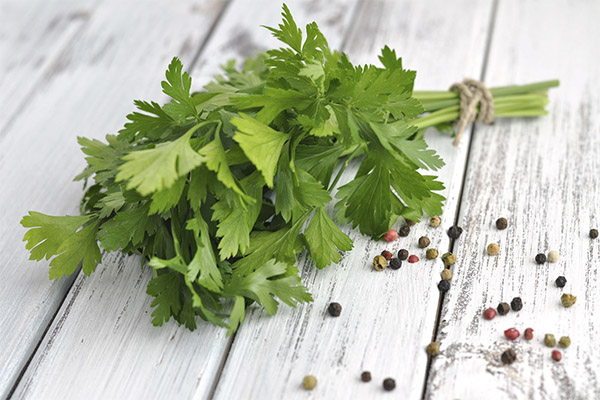
For diabetes
It has been proven that parsley contains inulin, which is involved in the metabolism of glucose, which is why it is useful for diabetes. In addition, parsley helps to get rid of excess weight, which is either the cause of this disease, or at least - an aggravating factor.
Important: The glycemic index of parsley is 5 units.
For pancreatitis
In acute pancreatitis, all herbs are contraindicated. In chronic pancreatitis parsley, more precisely - its greens, is one of the few allowed spices. It can be added to soups, meat and fish dishes. But in phytotherapy for the treatment of chronic pancreatitis is used parsley root. This option will be considered below among the recipes of folk medicine.
With gastritis.
Parsley is recommended to use in gastritis with reduced acidity, because it stimulates the production of gastric juice. It is desirable to do this on an empty stomach.
With gastritis with hyperacidity, parsley is one of the few allowed spices. But you can use it only if it is a chronic form of the disease and the remission stage.
For the intestines
Parsley is used to enhance intestinal peristalsis and improve digestion. It should be noted that it reduces the risk of increased gas, so it is used in irritable bowel syndrome.
For constipation
For this kind of problems, nutritionists most often advise simply adding fresh parsley to various dishes, although you can also drink infusions and decoctions.
For gout
In this disease, any spicy herbs should be used with caution. But in this case, there are direct contraindications, because the use of parsley can lead to a disturbance of salt metabolism, which is the main cause of the development of gout.
For the liver
For the hepatobiliary system, parsley is useful as a detoxifying agent. In folk medicine, it is recommended to prepare on its basis the following remedy: mix the juice of three lemons with a cup of chopped fresh parsley greens and five sprigs of steamed celery. All this is literally pureed in a blender, add 6 cups of water and then once again whip until smooth. You get a drink, which should be drunk in a cup three times a day before meals. The duration of the course of treatment is 3 days, then you need to take a break. In the presence of gastritis and peptic ulcer disease, this remedy is contraindicated.
Hemorrhoids
In this disease, it is very important to establish a correct process of digestion. For this purpose, it is advised to eat more leafy greens, but most importantly, parsley, because it also has anti-inflammatory properties and helps to strengthen blood vessels.
For cholelithiasis
The therapeutic diet for cholelithiasis allows the consumption of parsley greens - but no more than 60 g per day. In addition, you can add root to vegetable soup - no more than 30 g, because otherwise there is a risk of formation of oxalate stones.
For swelling.
Parsley contains apiin and potassium. Because of this, it has a diuretic effect, but, unlike ready-made pharmaceuticals, its use does not lead to hypokalemia. The diuretic properties of parsley make it effective against edema. However, it should be understood that neither the juice, nor the decoction, nor the infusion of this plant has no effect on the cause of edema, and the disease itself still needs to be treated.
Recipes of folk medicine based on parsley
Traditional folk medicine uses both seeds and leaves, and roots, and essential oil of parsley. Thus, the greens have always been used to treat bruises and insect bites, also its juice was considered an effective remedy for lice and skin parasites. Parsley essential oil has been used to normalize the menstrual cycle and to treat various gynecological diseases (but in general it should be used with extreme caution, because it gives an abortifacient effect as well).
Parsley seeds are an antipyrogenic remedy. On its basis is often brewed tea, which relieves flatulence and colic pain. And the decoction of the seeds is considered an excellent remedy for arrhythmia and heart failure, especially if these pathologies are accompanied by edema.
Finally, the root is often used as a diuretic for kidney disease, and it is also part of home remedies for diabetes and pancreatitis.
Many recipes based on parsley are approved by official medicine. For example:
- For pancreatitis, you need to take about 0.5 kg of parsley root, wash thoroughly, pour boiling water and cut into pieces. This mass is placed in a pan with thick walls and pour the milk so that it completely covers the raw plant material. In this way, you will be able to make the milk to melt, but not to boil it. When it thickens a little, strain the resulting remedy and take 1-2 tbsp. spoons every hour. In one day you should drink the whole amount of the prepared remedy. This remedy can be drunk even immediately after an attack of acute pancreatitis.
- With diabetes mellitus, the parsley decoction described above should be taken 1 tbsp. spoon three times a day.
- Another option for diabetes - 50 g of chopped roots, pour a glass of boiling water, infuse for 45 minutes, strain and take 2 tablespoons twice a day - in the morning on an empty stomach and in the evening half an hour before bedtime.
- When hypertension 15-20 grams of fresh parsley leaves infused with a glass of boiling water and infused for 20 minutes. This remedy to drink a little bit during the day. In a day you can drink no more than two glasses of infusion.
- There is another recipe for high blood pressure - 2 tablespoons pounded in a mortar seeds pour a glass of boiling water and simmer over low heat for 15 minutes. Then insist the drink for half an hour. Drink it by 1 tbsp. spoon four times a day.
Parsley in cosmetology
Parsley is often used for skin care. The juice of this plant helps to improve the complexion, makes the skin smooth and elastic. With regular use, it even allows you to get rid of age spots, as it has a slight bleaching effect. Also, this remedy is considered effective against acne, as parsley normalizes the sebaceous glands.
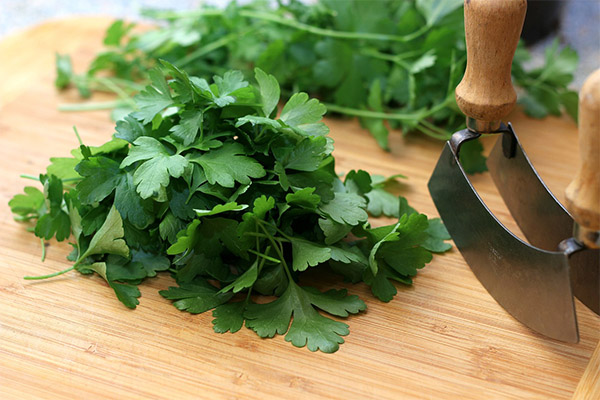
For the face
The best remedy in cosmetology is considered to be ice based on parsley greens or the juice of this herb. Such ice cubes wipe the skin in the morning and evening. This procedure replaces the usual washing, gives a slight whitening effect and tones the skin. It is important to move the ice cube correctly - from the center line of the face to the right or left, in a bottom-up direction. And, of course, it is very important not to allow overcooling during such procedures.
You can freeze for cosmetic ice and the above described decoctions and infusions, and the juice of the plant, and mineral water with parsley herbs. You can also prepare the following masks:
- For oily facial skin. Parsley greens are chopped in a blender so that the juice is formed. Add about the same amount of sour cream to 1 tablespoon of the resulting mass and stir it, and then the mixture is applied to cleansed skin for 20 minutes, then wash off with warm water without using additional products. Instead of sour cream, you can take fruit yogurt or any puree and nonfat kefir.
- For acne. For this mask you need parsley root. It is washed, peeled, crushed to a state of puree, taken from this 1 tbsp. raw material, mixed with raw egg white and lemon juice and applied to clean skin for 15 minutes, and then washed off. Some beauticians advise to use garlic instead of lemon, but the smell will be appropriate.
- For fading skin. Take dill and parsley in equal quantities, chop, of this volume 2 tbsp pour milk, add 2 ml of olive oil, stir and apply to the skin for 20 minutes. Also help compresses based on decoction of parsley.
- For dry skin. Boil oat flakes in milk as usual, but without adding sugar and salt. Then mix 50 gr. of porridge with 2 tablespoons of crushed parsley greens and 1 tablespoon of sour cream and apply the mixture to the face for 20 minutes.
Decoction of parsley can be wiped over the face where there are problem areas with pimples or traces of inflammation. It replaces the ready-made lotion.
For hair
- Decoction of parsley is used to give your hair a healthy shine - 50 grams of chopped greens per liter of boiling water. Infuse the mixture for 15 minutes, strain it and use as a rinse.
- Parsley juice is considered a good remedy for hair growth. It can be rubbed into the scalp even every day. But more often it is used once a week with some additives, such as honey or burdock oil.
- To strengthen the hair you can also make a mask based on ground parsley seeds (1 tsp.), which are mixed with castor oil (2 tsp.) and a small amount of alcohol, which in this recipe plays the role of preservative. The resulting product is rubbed into the scalp instead of lotion.
Culinary Applications
Parsley is the most important herb in Russian cuisine, but it plays an equally important role in European and even Asian culinary tradition. In most cases, when a recipe says "add herbs," it means parsley and some kind of additive to it. And one of the advantages of parsley is that it goes well with almost any of them. Its main companion is, of course, dill. But it is "friendly" with basil, celery, spinach, and even cilantro and green onions.
Parsley greens can be added to any salads and appetizers, it is suitable for soups, vegetable stews, various fish and meat dishes. It is sprinkled on scrambled eggs and even some kinds of unsweetened baked goods.
Parsley root is also widely used in cooking. It is put in soups, stews, various vegetable dishes, it can be part of the stuffing in stuffed zucchini or peppers. Also the root of this herb is added to cold cuts and jam.
Harms and contraindications
The large number of biologically active substances in parsley brings not only benefits. In some cases, this spice can even be harmful. As already noted, in large quantities parsley can significantly increase the tone of the uterus, so during pregnancy in the first trimester it should be consumed in very small doses, so as not to provoke a miscarriage.
In addition, it should be noted that parsley contains substances that, when consumed in large quantities, can lead to the formation of oxalate stones in the kidneys. Therefore, if you are prone to the formation of such concrements, the use of parsley is contraindicated. Also, this spice should be excluded from the diet in the presence of acute nephritis or cystitis, as well as gout.
How to choose and store parsley
Only fresh parsley should be bought. It should have leaves of a rich green hue and a resilient stem. Be sure to check it. The cut should be fresh. If the leaves look sluggish, even if there are no signs of rotting, it is better to refuse to buy, because such greens will not last long even in the refrigerator. If from the side of the cut there is an unpleasant smell, then you definitely should not buy such greens, because this means that they have been stored with violations of conditions.
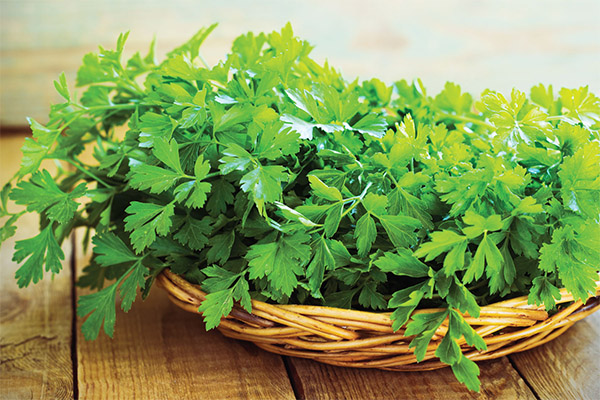
It is possible to extend the freshness period only for quality greens. To do this, you need to put parsley in cold water so that its stems are in it, and leave so at room temperature for several hours. Without a refrigerator, the greens can only be stored for 1-2 days. In the vegetable department of the refrigerator, they will "live" for a week. But for long-term storage, only one method is suitable - freezing, and it will be discussed below.
Root parsley is recommended to be stored in the same way as carrots. The dug up roots should be sorted out, the leaves should be cut off, and the broken or spoiled specimens should be got rid of. Then put the selected root crops for storage in boxes with sand and place them in the cellar. Some farmers even advise to slightly moisten the sand for longer storage, but here it is important not to overdo it.
In the conditions of a city apartment parsley root is stored in the refrigerator, only for this you need not a polyethylene, but a paper or cloth bag.
Can I freeze it?
Both leaf and root parsley for long-term storage can be frozen. If done properly, this spice can be stored in the freezer for at least 7-8 months, or even a few weeks longer.
The following methods are used for this purpose:
- Freezing with whole stems. Parsley is cleaned, washed, picked, and at the same time removing the coarse stems, and then dried on paper towels. After some time, while the greens have not yet lost their freshness, they are gathered into bundles, wrapped in plastic bags and sent to the freezer.
- In sliced form. The first stage of preparing the greens will be the same as described above, only parsley is chopped with a knife, and then packed into special bags or plastic boxes for freezing.
- In the form of portioned cubes. Parsley for this too must be carefully prepared, only cut it quite finely, and then placed in ice molds, adding literally a few drops of water in each compartment. The very next day, these molds can be taken out of the freezer, transferred to a more compact box and brought back.
Root parsley can also be frozen. To do this, the roots are sorted, leaving only the healthiest ones, then peeled of the skin and small side roots and lightly dried on paper towels. After that, the root can either be finely chopped or grated and the resulting mass can be frozen in storage bags.
Some housewives chop the prepared greens literally to a state of puree, then add a small amount of olive or other vegetable oil to the resulting mass and freeze in portion molds for ice in the same way as described above.
Of course, you cannot put such parsley in a salad that does not undergo heat treatment. It is used for soups, meat dishes, sauces, vegetable stews. But such parsley contains much more vitamins than greenhouse parsley. Yes, and its taste and aroma is much richer. But still, taking into account the fact that some of the useful substances are destroyed during freezing, you can add it to dishes a little more than you would need fresh summer parsley.
How to eat parsley right
This herb, although very useful, is not as simple as is commonly thought. Therefore, it is necessary to use it only according to the rules, so as not to harm the body.
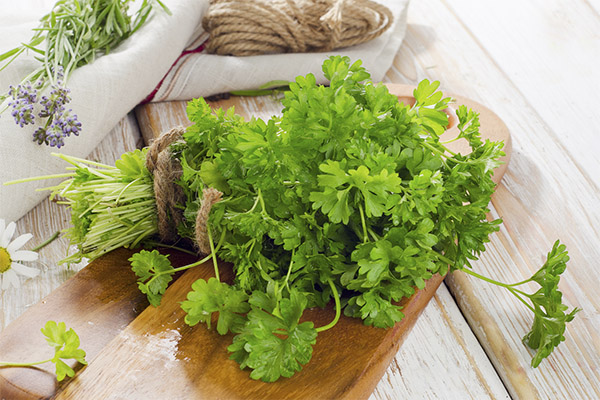
How much you can eat a day
Medics say that you can eat up to 50 g of parsley greens per day. Since its juice is more concentrated, it should be consumed with extreme caution. And finally, during pregnancy the amount of fresh parsley should also be reduced.
Is it possible to eat at night and on an empty stomach?
Very often glossy magazines suggest consuming parsley at bedtime. Of course, this really helps to lose weight by getting rid of swelling. But it can cause discomfort because of the diuretic effect throughout the night.
As for whether you can eat on an empty stomach, then again it is better to abstain, because the stomach mucosa will be strongly irritated because of the high content of essential oils.
Is it possible to eat stalks
Parsley stalks are not consumed fresh, but they can be used in cooking - for example, place a bunch of them in a hot broth when cooking so that they develop their flavor and aroma better (they can be thrown away later). Onions and carrots are often sautéed with a bunch of parsley stalks, especially if you use them for a sauce.
Also, parsley stalks, if they are long enough, are used to bind pancakes or other dishes with fillings, which is more convenient than using leaves. Chopped and dried stems can be mixed with salt to create a spice mixture.
Can I Eat Flowering Parsley
Parsley inflorescences are generally not eaten raw. But many housewives use them in the same way as dill florets, that is, they put them in jars with pickles and tomatoes for a more subtle flavor and aroma.
Can I give parsley to pets?
Small rodents like guinea pigs, hamsters and rabbits can and should be given parsley, but not more than twice a week. Dogs and cats are given parsley even less often. All these animals need greens to provide vitamins for their bodies. But birds such as wavy parrots should not be given parsley. The essential oils it contains are harmful to them.
Interesting facts about parsley
The name of this herb - "parsley" - comes from its Latin name Petroselinum crispum, which translates as "growing on a rock". This seemingly inconspicuous but amazing plant, in 100 grams it contains more vitamin C than lemons. Its healing properties have been known since ancient times. And, if legends are to be believed, parsley was especially appreciated by the French queen Maria de Medici, believing it to be an excellent remedy for moping and depression.
«Important: All information on this site is provided for informational purposes only. for informational purposes only. Please consult with your health care professional before using any of the recommendations. specialist before using any of the recommendations. Neither the editors nor the authors shall be liable for any possible harm caused by materials."

